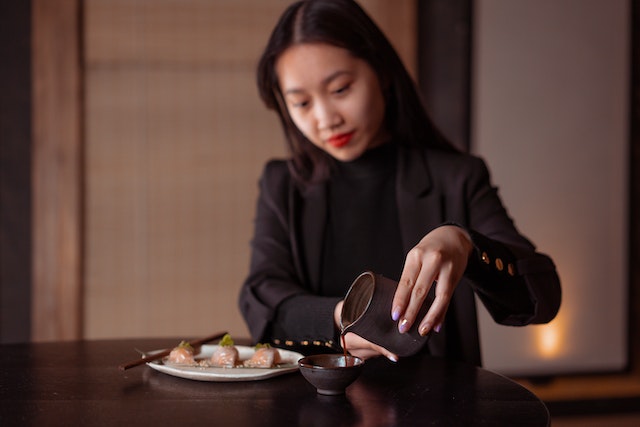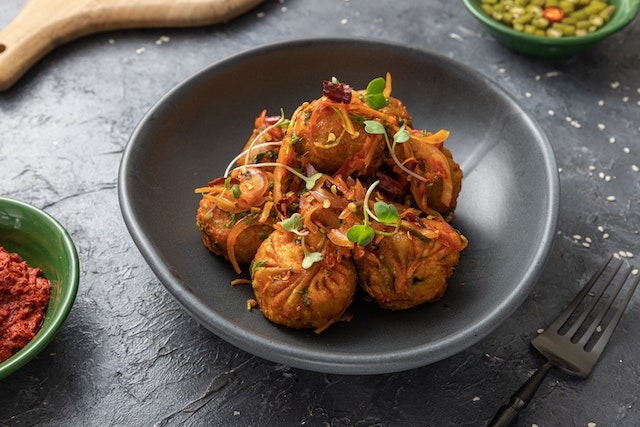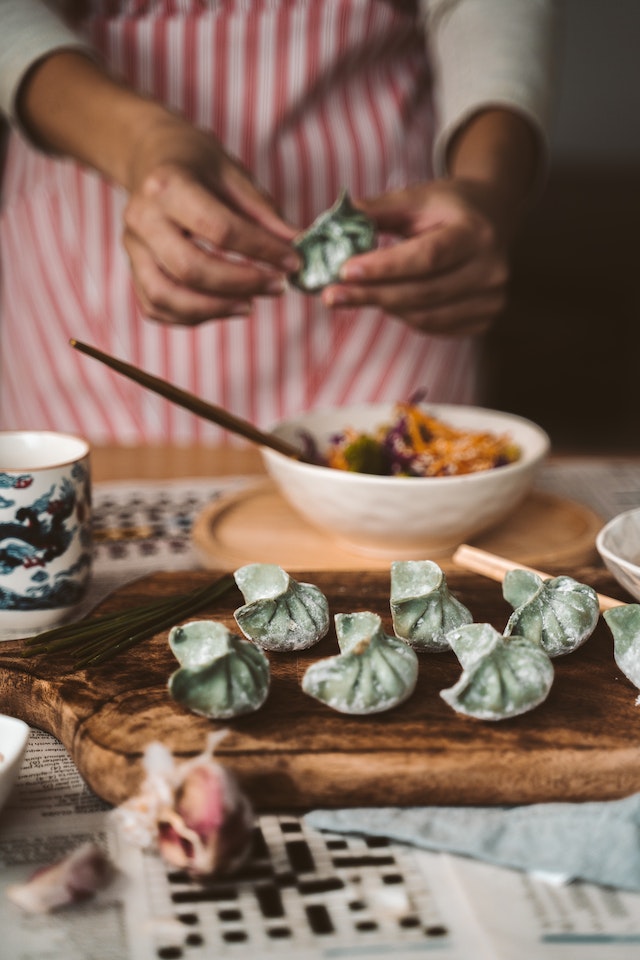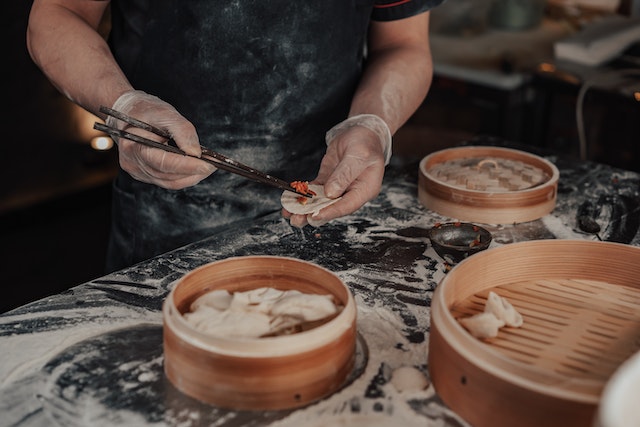
Dim sum, an integral part of Chinese culinary heritage, is a delightful style of dining that has captured the hearts and taste buds of people worldwide. Its name, which translates to “touch the heart,” perfectly captures the essence of this delectable tradition.
Originating in the vibrant tea houses of Guangzhou, southern China, dim sum has evolved into a cherished social experience that brings family and friends together. It is customary to gather around steaming bamboo baskets, filled with an assortment of bite-sized delicacies, all meticulously crafted to satiate the senses.
At its core, dim sum represents the epitome of simplicity and balance. The dishes are typically prepared using a combination of steaming, frying, and baking techniques, resulting in a harmonious blend of flavors and textures. From succulent dumplings and fluffy buns to savory rolls and crispy cakes, each morsel offers a unique culinary adventure.
The Dim Sum Menu
When it comes to dim sum, the menu is an integral part of the whole experience. Filled with an array of tantalizing options, the dim sum menu offers something for every palate. From classics that have stood the test of time to innovative creations that push the boundaries of tradition, the dim sum menu is a treasure trove of delectable surprises.
Steamed Delights
Steamed dumplings, a staple of dim sum, are a testament to the artistry of Chinese cuisine. Each bite-sized dumpling is carefully crafted to perfection, with delicate skins encapsulating a harmonious blend of fillings. From the iconic har gow, which features plump shrimp encased in translucent wrappers, to the traditional siu mai, bursting with a flavorful combination of ground pork and shrimp, the steamed section of the menu promises an unforgettable taste experience.
Baked and Fried Temptations
For those craving a crispy texture and indulgent flavors, the baked and fried section of the dim sum menu is a true joy. With treats like sesame balls, stuffed with sweet lotus paste and coated in a crunchy exterior, or the savory taro puffs, filled with a succulent mixture of diced meats and vegetables, this section offers a playful contrast to the steamed delicacies. Each bite brings a satisfying crunch, unveiling layers of delightful surprises.
Sweet Endings
No dim sum meal is complete without a sweet finale. The sweet endings section of the menu is a haven for those with a sweet tooth, featuring treats like mango pudding, silky egg custard tarts, and the iconic deep-fried sesame balls oozing with molten black sesame paste. Each bite is a taste of pure bliss, leaving a lingering sweet memory on the taste buds.
Fluffy Buns and Rolls
Soft, pillowy buns and rolls take center stage in this section of the dim sum menu. Whether stuffed with barbecued pork, tender chicken, or even sweet custard, these treats offer a symphony of flavors and textures. Bite into a char siu bao, and you’ll be greeted by a mouthwatering combination of sweet and savory, while a steamed roast pork bun will delight with its melt-in-your-mouth tenderness. The options are endless, ensuring that every diner finds their perfect match.

The Dim Sum Restaurant Experience
Walking into a dim sum restaurant is like stepping into a world of delectable delights. The air is filled with the aroma of freshly steamed dumplings, the clattering sound of plates and chopsticks, and the vibrant chatter of diners eagerly awaiting their culinary adventure. Let us take you on a journey through the various facets of the dim sum restaurant experience.
1. The Warm Welcome
As you enter a dim sum restaurant, you are greeted with warm smiles and the sound of bustling activity. Friendly servers guide you to your table, ensuring your comfort and setting the stage for an unforgettable dining experience. The atmosphere is lively, creating an ambiance that instantly uplifts your spirits.
2. Perusing the Menu
Dim sum menus are a tapestry of tantalizing options, offering a wide range of dishes to suit every taste and preference. From traditional favorites to innovative creations, each item promises a unique burst of flavor. Take your time to peruse the menu, allowing your imagination to wander through the culinary possibilities that lie ahead.
3. The Art of Selection
Ordering dim sum is an art in itself. Armed with a checklist or a pencil in hand, you select your desired dishes by ticking off the items on the menu. The server swiftly takes note of your choices, ensuring that each delectable morsel is prepared with precision and care. This process encourages exploration and invites you to indulge in new flavors and textures.
4. The Parade of Delights
As you settle into your seat, the anticipation builds, and the parade of steaming baskets begins. Dim sum carts, adorned with a colorful array of dishes, weave through the restaurant, presenting a captivating spectacle.

Each dish is a work of art, meticulously crafted to please both the eyes and the palate. The servers describe each offering, allowing you to make an informed decision before your plate overflows with culinary treasures.
5. Sharing the Feast
Dim sum is an experience best shared with loved ones. The communal nature of the meal brings people together, enhancing the joy of discovery and creating lasting memories. Diners excitedly sample various dishes, exchanging playful banter and animated reactions to each flavorful bite. The act of sharing strengthens bonds and adds a layer of conviviality to the dining experience.
6. Savoring the Moments
In the midst of the lively ambiance, take a moment to appreciate the flavors dancing on your tongue. The combination of textures and tastes, from the tender dumplings to the crispy rolls, creates a symphony of sensations. Close your eyes, savor each bite, and let the flavors transport you to the heart of Chinese culinary traditions.
Dim Sum and Tea: A Perfect Pairing

In the world of dim sum, tea takes center stage, adding a layer of sophistication and complementing the flavors of the bite-sized delicacies. The pairing of dim sum and tea is steeped in tradition and plays a vital role in enhancing the dining experience.
Let us explore the art of this perfect duo, from the different types of tea to the rituals and customs surrounding their consumption.
1. The Tea Selection
- Fragrant Green Tea: Delicate and refreshing, green tea is a popular choice to accompany dim sum. With its light, grassy notes, it cleanses the palate between bites, allowing you to fully appreciate the intricate flavors of each dish.
- Aromatic Jasmine Tea: Infused with the enchanting fragrance of jasmine flowers, this tea creates a symphony of scents that harmonize with the diverse flavors of dim sum. With its soothing qualities, jasmine tea provides a calming companion to the feast.
- Robust Black Tea: For those seeking a stronger, bolder taste, black tea serves as an excellent option. Its rich, malty flavor stands up well against the robust flavors of dim sum, elevating the dining experience to greater heights.
2. The Art of Tea Pouring
- The Purity Ritual: Before the tea is served, it is customary for the server to pour a small amount of hot water over the tea leaves. This ritual, known as the purity ritual, cleanses the tea and brings out its true essence.
- Tea Pouring Technique: With great finesse, the server pours the tea from a teapot with a long spout into small cups, ensuring an even distribution of fragrance and flavor. The height and speed at which the tea is poured can vary, adding an element of elegance and showmanship to the ritual.
3. Tea and Taste Pairings
- Light and Delicate Teas: Green and white teas pair harmoniously with steamed dim sum dishes, such as dumplings and rolls. Their subtle flavors allow the delicate fillings to shine, without overpowering the palate.
- Strong and Bold Teas: Robust black teas are the perfect partners for heartier dim sum dishes, like baked or fried options. Their robust flavors provide a contrasting note that complements the richness and depth of these dishes.
- Floral and Fragrant Teas: The aromatic jasmine tea pairs beautifully with sweet dim sum treats, such as custard tarts or sesame balls. The floral notes of the tea enhance the sweetness of the dessert, creating a delightful sensory experience.
4. The Tea Appreciation:
- Sipping and Savoring: Take a moment to appreciate the aroma and flavors of the tea with each sip. Notice the subtle nuances, the smooth texture, and the warming sensation as the tea cascades down your throat. Let the tea cleanse and awaken your taste buds before delving into the next dim sum delight.
- Conversation and Connection: Dim sum and tea create an atmosphere conducive to conversation and connection. As you share stories, laughter, and experiences over a steaming cup of tea, the bonds between friends and family grow stronger. The act of drinking tea together becomes a ritual of togetherness.
Making Dim Sum at Home
While enjoying dim sum at a restaurant is a delightful experience, why not try your hand at making these mouth-watering delicacies in the comfort of your own kitchen? With a little patience and a dash of creativity, you can recreate the magic of dim sum right at home. From dumplings to buns, this section will guide you through the art of making dim sum from scratch.

Gathering Your Ingredients:
To embark on your dim sum adventure, make sure you have all the necessary ingredients at hand. Head to your local Asian market to stock up on essentials like shrimp, pork, chicken, mushrooms, and bamboo shoots. Don’t forget the basics, such as soy sauce, sesame oil, cornstarch, and oyster sauce, as these will bring depth and flavor to your creations.
Mastering the Techniques:
Dim sum making is an art that requires precision and practice. Start by honing your skills in the basic techniques that form the foundation of dim sum preparation:
1. Folding Dumplings: Whether it’s the classic crescent-shaped jiaozi or the intricate pleats of a har gow, mastering the art of dumpling folding is essential. Take your time, follow online tutorials, and soon you will be creating beautifully shaped dumplings that would impress even the most discerning dim sum connoisseur.
2. Steaming: Steaming is a fundamental cooking technique in dim sum preparation. Invest in a bamboo steamer, as it gives the dishes an authentic touch while maintaining their delicate textures. Brush the steamer with oil before placing the dumplings or buns to prevent sticking.
3. Frying: Crispy fried dim sum treats, like spring rolls and taro puffs, add a satisfying crunch to your homemade dim sum feast. Mastering the art of frying requires controlling oil temperature and achieving a golden, crisp exterior without compromising the delicate fillings.
4. Embracing Creativity: While staying true to traditional recipes is great, don’t be afraid to infuse your dim sum creations with a touch of creativity. Experiment with unique fillings, such as spicy tofu or vegetarian options like mushroom and spinach. You can also play around with different shapes and sizes to create surprises on the dining table.

5. Shaping the Dim Sum Menu: To recreate the dim sum experience at home, curate your own menu that reflects your favorite flavors and preferences. Choose from a variety of dumplings, buns, rolls, and sweets, catering to the diverse tastes of your family and friends. Remember, the art of dim sum lies in the balance of flavors, textures, and presentation.
6. A Feast for the Senses: Dim sum is not just about the taste; it is a visual feast as well. Pay attention to the presentation of your homemade creations. Arrange them on a beautiful platter, garnish with fresh herbs or chilies, and let the vibrant colors and enticing aromas entice your guests.
With a little practice, making dim sum at home can be a rewarding and enjoyable experience. Take the time to perfect your folding techniques, experiment with flavors, and unleash your culinary creativity. Gather your loved ones around the table, and let the homemade dim sum delights create unforgettable memories in the heart of your home.
